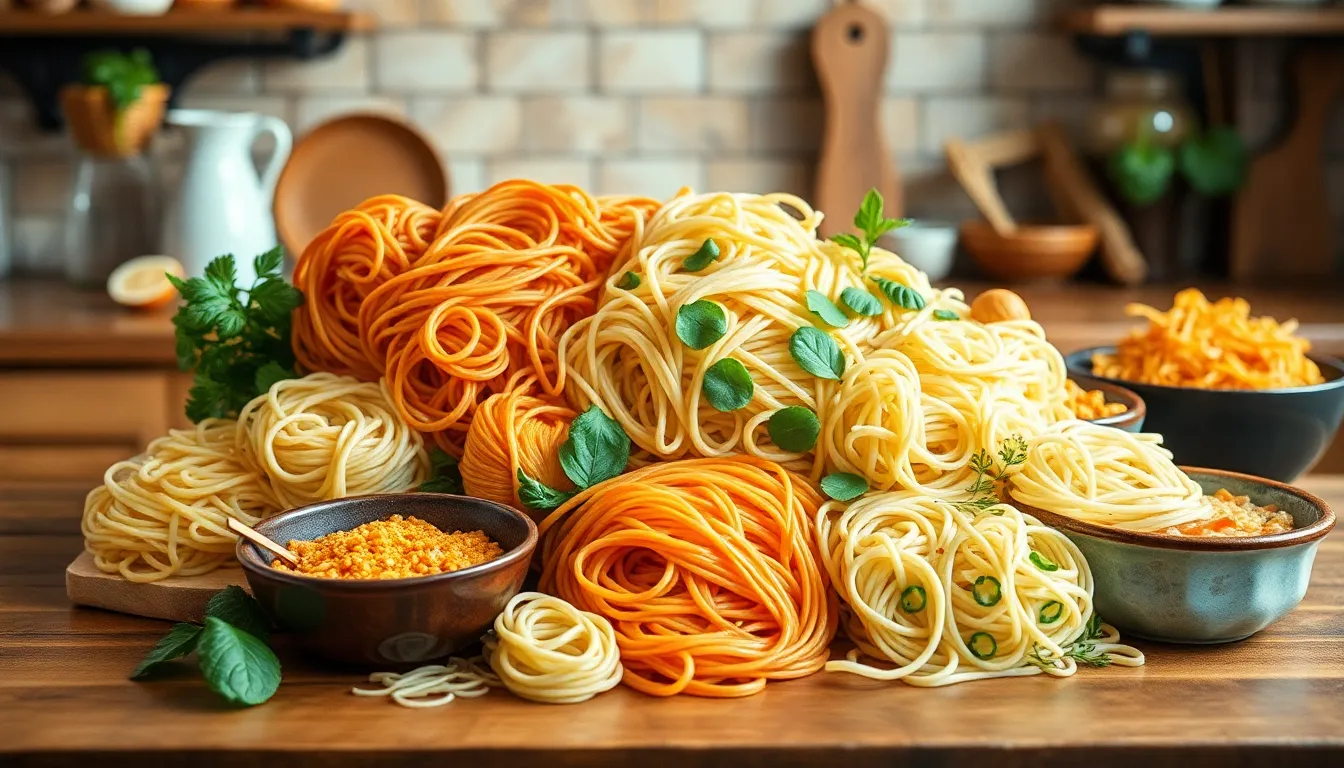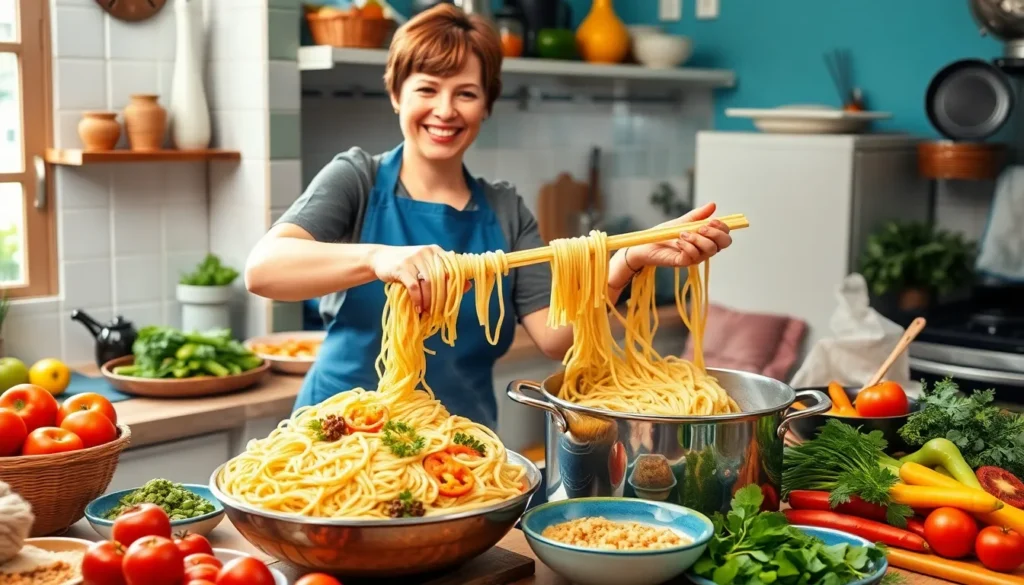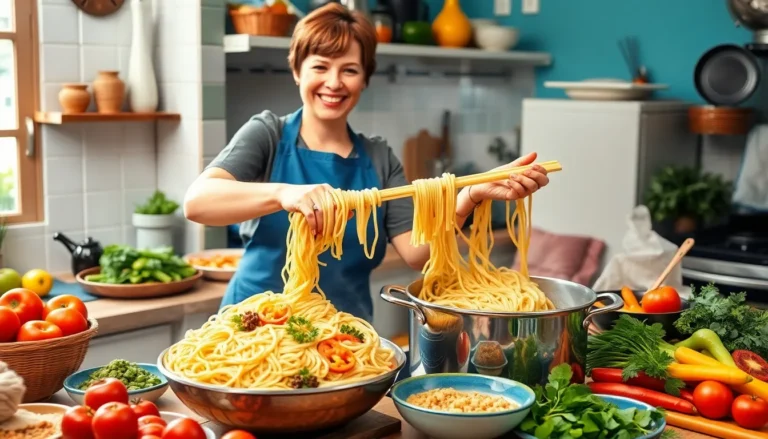When it comes to creating the perfect zavagouda, the choice of noodles can make or break the dish. Imagine slurping up those delightful flavors, only to find your noodles are as out of place as a cat at a dog show. The right noodles not only enhance the dish but also elevate your culinary game to Michelin-star levels—or at least to a solid dinner party success.
Table of Contents
ToggleUnderstanding Zavagouda
Zavagouda is a unique dish that relies heavily on the type of noodles used. Selecting appropriate noodles plays a critical role in achieving the desired texture and flavor. Handmade noodles often add an authentic touch, providing a chewiness that complements the dish’s rich ingredients. Some popular options include egg noodles and udon noodles, known for their thickness and ability to hold sauces well.
A key consideration involves the sauce’s consistency. Thinner noodles tend to absorb more flavor, allowing the rich, savory elements of zavagouda to shine. Conversely, thicker noodles offer a satisfying bite that enhances the overall experience. Flavor profiles of noodles can vary significantly, impacting the meal’s taste. For instance, whole wheat noodles introduce a nuttier flavor, while rice noodles provide a lighter base.
Texture should also influence noodle selection. Ideal noodles create harmony with other components in the dish. If the goal is a balanced mouthfeel, lighter options like vermicelli can work well, while chewy options like soba noodles can add complexity. Different preparation methods, such as boiling or frying, can affect the noodles’ final state as well.
Ultimately, the right noodles elevate zavagouda by enhancing its flavors and overall presentation. Considering personal preferences and dietary requirements is essential when choosing. Experimentation often leads to discovering unique combinations that surprise and delight the palate. Crafting the perfect zavagouda involves thoughtful noodle selection to achieve a memorable culinary experience.
Types of Noodles for Zavagouda

Choosing the right noodles for zavagouda can enhance its taste and texture significantly. Various options are available to suit different preferences.
Traditional Noodle Options
Egg noodles are a classic choice for zavagouda. Their richness and thickness make them excellent at holding onto sauces. Handcrafted noodles also contribute an authentic chewiness that complements the dish’s flavors. Udon noodles offer a similar thick, hearty texture, perfect for balancing the rich ingredients. Another popular option is fettuccine, which provides a flat surface to absorb the sauce effectively. Each of these traditional noodles adds a distinct character to the dish.
Modern Noodle Variants
Soba noodles introduce a unique flavor due to their buckwheat base. These noodles add complexity and chewiness, enhancing the overall experience. Vermicelli brings a lighter touch, allowing the flavors of the sauce to shine through. Zucchini noodles offer a gluten-free alternative while maintaining freshness. Rice noodles provide yet another option, with their subtle texture that absorbs sauces well. Experimentation with these modern variants can lead to delightful culinary discoveries.
Cooking Techniques for Noodles
Selecting the cooking method influences the texture and flavor of noodles in zavagouda. Boiling provides a classic technique for most noodle types. Start with a large pot of salted water, bringing it to a rolling boil before adding the noodles. Cooking time varies by noodle type, with egg noodles typically requiring 5 to 7 minutes of boiling.
Stirring often prevents noodles from clumping together, ensuring even cooking. Rinsing noodles under cold water post-cooking helps stop the cooking process and removes excess starch, which can create a better sauce-clinging surface.
Sautéing presents another popular method, especially with fresh or handmade noodles. Sautéing in olive oil or butter for a few minutes adds depth to flavor and promotes a satisfying chewiness. Udon noodles benefit greatly from this technique, as they absorb the flavors of added vegetables and proteins.
Baking can introduce a unique texture to noodles like fettuccine. Combining cooked noodles with sauce in a baking dish, then topping with cheese and herbs creates a comforting baked dish. The baking process melds flavors together, enhancing the overall taste of zavagouda.
Steaming offers a healthier cooking alternative, preserving nutrients without added fat. Placing noodles in a steamer basket for approximately 5 to 10 minutes produces tender noodles that maintain their integrity. This method works excellently for lighter options like vermicelli.
Choosing the right cooking technique considerably impacts the final dish. Experimentation encourages discovering which methods suit personal preferences and desired flavor profiles for zavagouda.
Best Practices for Preparing Zavagouda
Selecting the right noodles plays a vital role in preparing zavagouda. Handmade noodles enhance authenticity, offering a chewy texture that complements rich ingredients. Egg noodles and udon noodles provide thickness, allowing them to hold sauces effectively. Thinner noodles, like vermicelli, absorb flavor well and create a lighter balance, while thicker options, such as soba, add a satisfying bite.
Cooking methods also influence the final outcome of the dish. Boiling remains a classic technique; different noodle types require specific cooking times. For instance, fresher noodles may need shorter boiling durations. Stirring during cooking prevents clumping and improves adherence to the sauce, ensuring each bite delivers flavor.
Sautéing introduces an additional depth of flavor, especially with fresh or handmade noodles. Baking transforms dishes, creating comfort when using fettuccine, while steaming serves as a healthier cooking alternative. This method preserves nutrients and maintains the noodles’ integrity.
Experimentation enhances the culinary experience. Trying various noodle types and cooking methods allows individuals to discover unique combinations. Personal preferences should guide noodle choice, while dietary requirements can dictate suitable options. Understanding flavor profiles and textures creates opportunities for creative adaptations that elevate zavagouda.
Best practices for preparing zavagouda encompass selecting the right noodles, utilizing effective cooking techniques, and being open to experimentation with various combinations. These approaches result in a delightful dish that impresses guests and satisfies personal tastes.
Choosing the right noodles for zavagouda is essential for achieving a memorable dish. The interplay of flavors and textures can elevate the entire dining experience. From handmade options to modern alternatives each noodle type brings its unique characteristics to the table.
Experimenting with different noodles not only satisfies personal preferences but also opens up a world of culinary possibilities. Whether opting for traditional egg noodles or lighter vermicelli the right choice can make all the difference. Embracing various cooking techniques further enhances the noodles’ qualities ensuring a delightful meal that impresses everyone.



